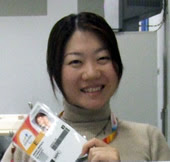
Not only is Mami Sato a Paralympian long jumper, she's also a first-class speaker. Yesterday (March 1) I accompanied her to Tokiwamatsu Elementary school in Tokyo's Shibuya Ward. Tokyo's a big city with a population of more than 12 million living within the metropolitan boundaries. So it seemed a bit incongruous to visit an elementary school with only slightly more than 120 students in six grades.

After a meeting with the school principal, Tomiko Mori, a vivacious woman who obviously took her position seriously and was concerned with the welfare of each of her charges, we went to the gymnasium, where the entire student body greeted Mami with a standing ovation, then sat cross-legged on the floor to listen to her speak.
Mami spoke of her childhood and how she decided at an early age not to let her love of sports and athletics interfere with her need to study. "You can do both," she said. "And both are important."
She spent her elementary and junior high years in her home town of Kesennuma, in Miyagi Prefecture, but decided to attend a boarding high school in Sendai, the prefectural capital. While there, she was not only a top-notch athlete, she also studied hard enough to pass the entrance exam to Waseda University, one of Japan's most prestigious private schools.
First she told the kids about her days on the cheerleading squad. Then she quietly recounted discovering that she had bone cancer and would have to lose her right leg below the knee. More than a hundred children and a bevy of adults listened in total silence as Mami related the feelings she had while fighting cancer, and how she turned to sports to build a new life.

Standing before her audience, Mami looked absolutely normal, if that's the word to use. The children surely didn't totally realize what she was talking about. Until she brought out her sports leg.

It doesn't look like a leg, unlike Mami's other prothesis.
"How heavy is it," a third grader wanted to know.
"Here, lift it. See? It's heavier than it looks, right?" Mami never lost her trademark smile, and the children were enthralled.

Mami took off her daily prothesis and fitted the sports leg. She showed the children how it fit and what kept it from falling off. She showed them how it provided spring when she ran. She even ran a race with some students across the gym. With that, she ended her talk and the 5th grader MC opened the floor for questions. At first the questions were ones that had been prepared in advance with one spokesperson per grade. Then came the Monster game.

Playing the "Look for a Monster" game allowed children to come in close contact with Mami. The questions became ones that children really want to know. "Does it still hurt?" "Was it hard to learn to walk?" Things like that.

The 4th grade hosted Mami and I for lunch of sardine, daikon radish, egg-drop soup, and a 180cc glass bottle of milk. Some of the guys went back for seconds. The lunch was nourishing and well balanced, undoubtedly the work of a professional nutritionist.
After a short meeting with the PTA mothers, we left the Tokiwamatsu Elementary School behind. I drove Mami to Shibuya station and myself back to the office in Monzen Nakacho.
I have no doubt that these youngsters will remember Mami Sato for the rest of their lives. And I think they'll watch the Paralympic games. They'll certainly view people with physical disabilities with different eyes now, thanks to Mami's superb presentation and selfless mingling with a hundred and more young students.

































